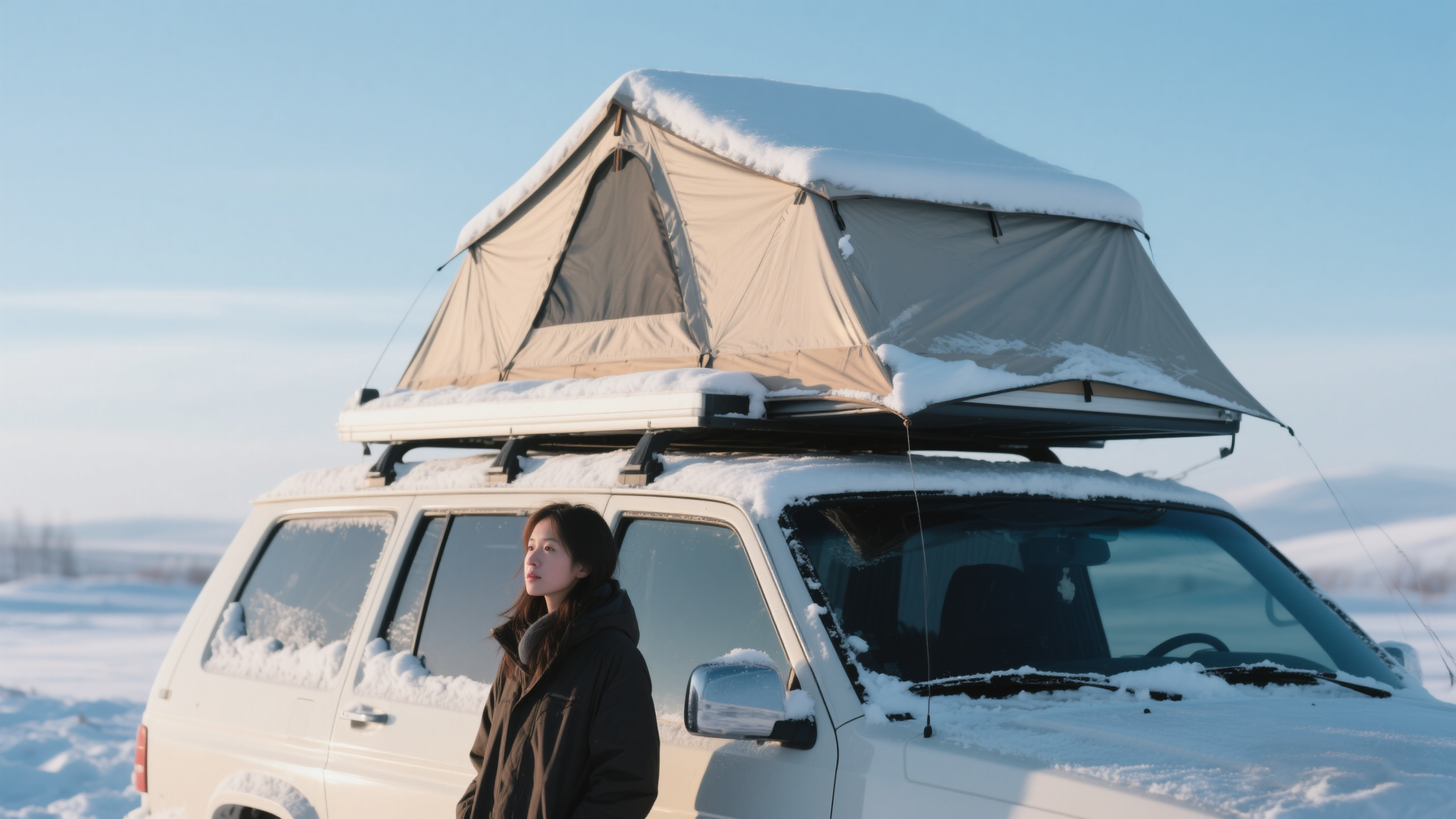Understanding SUV Roof Tent Performance in Cold Weather
How rooftop tent insulation impacts winter usability
The quality of insulation in a roof tent really makes all the difference between getting a good night's sleep or waking up shivering from the cold. High end winter models typically feature multiple fabric layers combined with either closed cell foam or reflective materials inside, which can retain heat about 70 percent better compared to regular camping tents according to Outdoor Gear Lab tests last year. The Winter Camping Report for 2023 showed something similar too, finding that tents equipped with thermal liners kept interiors around 8 to 12 degrees Fahrenheit warmer than those without any insulation at all. But there's a catch worth mentioning here. Too much insulation without enough airflow will trap moisture inside, causing ice to form on surfaces. Getting this right remains quite challenging for most manufacturers in the market today.
Key differences between all-season and 4-season roof top tents
While all-season tents handle light snow, true 4-season models feature:
- Reinforced aluminum frames (35% thicker than standard)
- Double-wall construction with 2.5” air gaps for thermal breaks
- Polycotton canvas (300gsm+) instead of standard polyester
- Zippers rated for -40°F operation
These designs withstand 55+ mph winds and 18” snow loads, whereas all-season tents risk collapse under 30 mph gusts and 6” snowfall.
Thermal efficiency of hard shell vs soft shell roof top tents for winter
| Feature | Hard Shell | Soft Shell |
|---|---|---|
| R-value | 5.1 (with insulation) | 3.8 (with liner) |
| Setup Time | 90 seconds | 7–10 minutes |
| Cold-Weather Durability | ABS plastic remains brittle until -76°F | Nylon sags below 14°F |
| Energy Efficiency | 22% less heater fuel used | Requires 30% more BTU input |
Hard shells outperform in wind and snow, but soft shells offer better ventilation–ideal for coastal winter climates where humidity control is essential.
Essential Insulation and Build Features for Winter Use
Insulation materials used in cold-weather roof top tents
SUV roof tents designed for winter adventures depend heavily on good insulation systems to keep campers warm. At the top end of the market, manufacturers are now using materials like aerogel infused fabrics that have impressive thermal properties around 0.018 W/mK conductivity, or they're incorporating closed cell foam layers similar to what's found in those fancy sleeping pads used in Arctic expeditions. For folks looking at mid range products, many brands offer tents filled with synthetic materials ranging from about 100 to 150 grams per square meter, such as PrimaLoft Gold. These materials maintain roughly 95 percent of their insulating capability even when wet, which makes all the difference during unexpected snow showers. Recent research published in 2023 through thermal imaging technology demonstrated something pretty interesting too full coverage insulation mats can cut down heat loss by nearly 40 percent compared to basic models without proper lining.
Double-wall construction and thermal breaks in 4-season designs
Winter tents worth their salt have those separate inner and outer walls with about 4 to 6 inches of space in between them. This gap works kind of like insulation, keeping cold air out while trapping warmth inside. The really good ones throw in these special membranes between layers that stop moisture from turning into ice on the inside walls. Makes sense when you think about it because nobody wants frost building up while they sleep. For frames, top manufacturers go with aluminum channels but put plastic inserts in there too. These breaks stop heat from escaping through conduction. Some tests showed that these designs keep interiors about 30 percent warmer at minus 15 degrees Celsius compared to regular metal frames. Pretty impressive difference when temperatures drop that low.
Evaluating R-values: How well do SUV roof tents retain heat?
Residential insulation typically sticks to ASTM C518 guidelines, but when it comes to roof tents, things get a bit different with their own version of ISO 23538 standards. The best winter models can hit around R-5 to R-7, which actually puts them on par with what most people would expect from a good 3-season sleeping bag. Meanwhile, those cheaper "4-season" tents that marketers love to tout? They usually only manage R-2.5 to R-3.5 at best, not nearly enough if someone plans to spend multiple nights in below freezing temperatures. From actual tests out in the field, campers generally need at least an R-4.1 rating just to stay comfortable during an overnight trip when temps drop to about -12 degrees Celsius, assuming they're using regular sleeping bags and pads without anything fancy.
Are most '4-season' claims overstated? Separating marketing from reality
Only 23% of tents marketed as "4-season" meet mountaineering-grade EN 335B standards in independent 2024 verification tests. Genuine winter capability is indicated by:
- Seam-sealed 300D polycotton fabric (₵5g/m²/24hr vapor permeability)
- Dual-layer windows with removable inner panels
- Integrated condensation gutters
Consumer reports show 61% of buyers needed supplemental heaters below -7°C, highlighting widespread performance exaggeration in product claims.
Effective Heating and Climate Control Solutions
Diesel heater compatibility with SUV roof tents: Safety and setup
When temps drop below freezing, diesel heaters are still one of the best bets for keeping warm out there. The newer portable models will actually hold around 68 degrees Fahrenheit inside even when it's well below zero outside, as long as they're set up right. But folks need to know about the safety stuff first. Make sure those exhaust pipes point down so CO doesn't sneak back in while sleeping. Get good quality insulated hoses rated for super cold temps, maybe something that works down to minus 30 Celsius. And keep fuel tanks outside the tent walls completely. We've seen too many campers forget this basic rule and end up with a real mess on their hands during those long winter trips.
Electric heaters and battery requirements for winter camping
Electric heating demands significant power–a 1500W heater drains a 100Ah lithium battery in 2–3 hours. Dual-battery SUV setups paired with 400W solar arrays extend runtime to 8 hours during daylight. New low-wattage ceramic models (500W) paired with efficient enclosures reduce energy consumption by 40%, maintaining base temperatures around 55°F (13°C).
Passive heating methods: Thermal blankets and radiant barriers
Reflective liners beneath mattresses trap up to 75% of body heat, while vapor barriers between sleeping bags and pads prevent moisture buildup that degrades insulation. Placing dark-colored water containers inside the tent absorbs solar radiation during the day, releasing 200–300 BTU/hour overnight–enough to raise interior temperatures by 5–7°F.
Weather Resistance: Snow, Wind, and Waterproofing
Roof top tent performance in snow and subzero temperatures
Quality SUV roof tents remain structurally sound below -40°F (-40°C), with reinforced aluminum frames supporting snow loads up to 150 lb/ft² (731 kg/m²). Fabrics like 420D poly-cotton blends resist stiffening in extreme cold, preventing seam splitting during rapid freeze-thaw cycles.
Wind stability and aerodynamics of SUV-mounted tents in winter storms
Aerodynamic hard-shell designs reduce wind uplift by 38% compared to soft-shell models, maintaining stability in 55+ MPH (89 km/h) gusts. Integrated wind deflectors and triangular cross-bracing distribute forces evenly across the vehicle’s roof rails, minimizing stress points.
Waterproofing seams and zippers under freezing conditions
Winter-ready tents combine 10,000mm+ waterproof ratings with freeze-resistant TPU tape that stays flexible at -30°F (-34°C). Overlapping zipper garages and breathable vents prevent ice buildup while managing condensation–key factors validated in cold-weather engineering studies.
Case Study: Winter expedition in the Rockies using a hard shell SUV roof tent
During a 2023 Wyoming expedition, a premium hard-shell tent endured 7 consecutive nights at -12°F (-24°C) with 22" (56 cm) of snowfall. Its wedge-shaped design shed snow within 90 minutes of stopping, while dual-layer polycarbonate walls maintained a 22°F (12°C) temperature differential without auxiliary heating.
Staying Warm and Comfortable: Practical Winter Tips
Layering strategies: Sleeping bags, pads, and vapor barriers
Start with base layers that wick away moisture. Synthetic materials work well, as do wool fabrics, which cut down on heat loss from sweat evaporation around 40% better than cotton does according to the Outdoor Industry Association report from 2024. When it comes time for sleep, match your cold rated sleeping bag something at least 10 degrees colder than what temperatures might actually drop to, along with an insulated pad rated R-5 minimum or better. Most experienced outdoor leaders suggest adding vapor barrier liners underneath the sleeping bag itself. These help keep insulation working properly by stopping moisture from moving through the fabric. Think of them as an extra layer of protection against dampness ruining all those careful preparations for staying warm during chilly nights in the wild.
Ventilation management to reduce condensation in cold weather
Crack roof vents 1–2 inches even in subzero conditions to balance humidity control and heat retention. Ice on tent walls signals poor airflow. Position breathable storage near vents to encourage convection currents that redirect moist air outward without creating drafts over sleeping areas.
Pre-heating tents and maintaining interior climate control
Get the tent nice and cozy by running a portable heater for around 15 to 20 minutes right before going to sleep, then let it naturally retain heat after that. Putting some insulated water bottles inside sleeping bags works pretty well too, giving off warmth for about six to eight hours in specific areas. This method actually works great when climbing mountains or doing other high altitude stuff. Keep an eye on things with a Bluetooth hygrometer device, trying to keep temperatures somewhere between low 40s and mid 50s Fahrenheit. That sweet spot makes for better sleep while not wasting too much power either.
Always ensure proper ventilation when using combustion-based heating devices.
FAQ
What are the best insulation materials for winter roof tents?
High-end tents use materials like aerogel infused fabrics and closed cell foam layers for superior insulation. Mid-range tents may feature synthetic materials like PrimaLoft Gold.
How can I prevent condensation inside my rooftop tent during winter?
Proper ventilation is key. Crack roof vents slightly even in cold temperatures, and use breathable storage near vents to encourage airflow.
Are diesel heaters safe to use in rooftop tents?
Yes, but ensure exhaust pipes point downward, use insulated hoses rated for cold temps, and keep fuel tanks outside the tent to ensure safety.
Why do some 4-season tents not perform well in winter?
Many "4-season" claims are overstated. Only a small percentage meet true mountaineering standards. Look for seam-sealed fabrics, dual-layer windows, and condensation gutters for genuine winter use.


